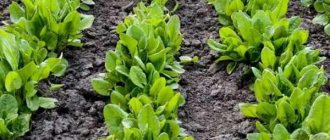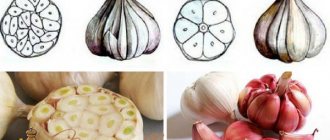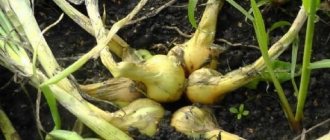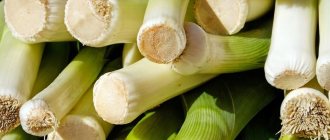The herbaceous plant celery (Apium) is a member of the Apiaceae family. The most popular vegetable among gardeners is celery (Apium graveolens). This culture comes from the Mediterranean, where it is still found in the wild today. Celery can be found in nature on the Hindustan Peninsula and in other Asian countries, as well as in America and Africa, and this plant prefers to grow in humid places.
People began to cultivate such a plant a very long time ago; for example, in Ancient Greece, celery was grown in a special way, and only leaf petioles were used for food. And in other countries of the Ancient World, this crop was a sacred plant; for example, in the Roman Empire and Egypt, celery was used to make decorations for graves, and food containing such a plant was used to remember the dead. On European territory, such a crop became popular in the 18th century, and at first it was grown only for decorative purposes, and only after some time it began to be eaten. Today, this plant is becoming more and more popular every year.
Brief description of cultivation
- Sowing . Root celery is sown for seedlings in the last days of February, and leaf celery - half a month later. Seedlings are planted in open ground in the first days of May.
- Illumination . Well lit area.
- Priming. Suitable soil should be light, loose and nutritious; sandy or loamy soil, which should be neutral or slightly alkaline, is best suited.
- Watering . Water once every 7 days, while 2–2.5 buckets of water are consumed per 1 square meter.
- Fertilizer . During the season, you will need to carry out 4 feedings: seedlings are fed with Nitrophoska solution 7 days after picking; herbal infusion 7 days after transplanting seedlings into open soil; after half a month, fertilize with a solution of mullein or chicken droppings; superphosphate solution in the last days of July.
- Reproduction . Generative (seed) method.
- Harmful insects . Celery (borscht) flies, carrot flies, bean aphids.
- Diseases . Rust, septoria (late burn, or white spot), cercospora (early burn), downy mildew and cucumber mosaic virus.
Timing for planting from seeds to seedlings
The timing of sowing celery seedlings depends primarily on the growing region . The varietal characteristics of the crop do not play a special role; in any case, gardeners are guided by the weather conditions of each individual area. Experienced farmers recommend focusing on the lunar calendar.
Depending on the variety
Varieties of petiole celery are divided into early and late . In Russia, this type of crop is not very popular compared to root and leaf crops, so there is a modest selection of seed material on store shelves. Almost all petiole celery seeds are imported.
On the packaging, manufacturers indicate the timing of sowing seeds for seedlings and planting in open ground.
For example, the early variety Malachite ripens within 90 days from the moment of germination. In the southern regions, it is rational to sow directly in open ground in mid-May; in other regions, the crop is grown through seedlings. To harvest the crop in late August - early September, sowing work begins no later than mid-March.
For reference. Late varieties of petiole celery are sown in February.
From region
To calculate the sowing time for petiole celery, the following factors are taken into account::
- seed germination period - 7-14 days;
- planting in soil heated to a minimum temperature of +6°C;
- the appearance of 4-5 true leaves in 60-70 days.
By adding up the time of seedlings and the time required for germination, a total of approximately 84 days is obtained. Based on this, sowing of petiole celery is carried out on the twentieth of February.
In regions with late spring and frequent frosts in May, the dates are shifted to late February - early March. Planting in the ground is carried out at the end of May - beginning of June.
Approximate timing of sowing petiole celery:
- in the south - late March - early April;
- in central regions - March;
- in the north - February - first ten days of March.
According to the lunar calendar
Favorable days for sowing petiole celery according to the phases of the moon for 2021:
- in February: 1-7, 24,25, 28, 29;
- in March: 2-6, 17,18, 27-30;
- in April: 1, 2, 5-8, 14, 24, 28;
- in May: 2, 3, 5-7, 25, 26, 30, 31.
Features of celery
The herbaceous plant celery is a biennial, it reaches a height of about 100 centimeters, its root is thickened. During the first year of growth, the bushes develop a root crop, as well as a rosette consisting of shiny pinnately dissected leaf plates of a dark green color. And in the second year of growth, shoots form, flowering begins in mid-July. The emerging umbrellas consist of greenish-white flowers.
This culture is moisture-loving and frost-resistant, seed germination is observed already at 3 degrees, while friendly shoots appear at a temperature of 15 degrees. Young seedlings can withstand frosts down to minus 5 degrees. The round, almost double fruit has thread-like ribs on each half. Today, 3 varieties of celery are cultivated: leaf, root and stem (petiole). The most popular green crops are: celery, dill and parsley.
Root celery - growing in productive beds
Celery plant - description
What does celery look like? The celery vegetable is a biennial herbaceous plant up to 1 m high with a thickened root. In the first year of life, it forms a root crop and a rosette of pinnately dissected, glossy, dark green leaves, and only in the second year does a celery stalk form, and by mid-July the plant blooms with greenish-white flowers collected in umbellate inflorescences.
Celery is a cold-resistant and moisture-loving plant, the seeds of which germinate already at 3 ºC, although the optimal temperature for germinating celery seeds is 15 ºC. The emerging seedlings can withstand frosts down to -5 ºC. The fruit of celery has a rounded shape, it is almost double, with thread-like ribs on each half. Three varieties of celery are grown in culture - root, leaf and petiole, or stem. Today, dill, celery and parsley are the most popular green crops in the garden and on the table.
We will tell you everything about growing and caring for celery: how to plant celery, how to grow celery, how to grow root celery, how growing leaf celery differs from growing stalk celery and how to protect all types of celery from diseases and pests. We hope that the information collected in our article is useful to you.
- Mint: growing from seeds at home and in the garden
Growing celery from seeds
What time to plant
Since the duration of the celery growing season is 120–170 days, this crop should be grown through seedlings. Sowing root celery seeds for seedlings is carried out 70–75 days before transplanting the seedlings into open soil, for example, in the last days of February. In this case, sowing of leaf celery for seedlings is carried out half a month later.
Seeds require mandatory pre-sowing preparation, as they contain essential oils that greatly inhibit swelling and the appearance of sprouts; in some cases, the first seedlings appear after 20–30 days. In order for the seeds to sprout as soon as possible, they must be bubbled: the seed is kept in oxygenated water for 24 hours, after which it is pickled by immersing it for 45 minutes. into a solution of potassium manganese (1%), then it should be thoroughly rinsed using clean water and dried. There is another method of preparing seeds for sowing: first, they are treated by immersing them for 45 minutes. in a solution of potassium manganese (1%), then they are washed, and then immersed in Epin solution for 18 hours (2 drops per 100 ml of water).
The treated seed should be scattered in a thin layer on a moistened cloth, where they will germinate at a temperature of 20 to 22 degrees. The hatched seeds are sown in a box, which is pre-filled with a fertile substrate, its composition includes low-lying peat, turf soil and humus (3: 1: 1), coarse sand is also added to it. To 10 liters of substrate you need to add 1 tbsp. wood ash and 1 tsp. urea. After some of the seeds have sprouted, they are mixed with a small amount of sand and sown in a container with a moistened soil mixture, in which furrows are made, and the distance between them should be from 30 to 40 mm. The seeds should be covered with a thin layer of sand using a sieve, then the box is covered with glass or film on top and put in a warm place.
Growing seedlings
If everything is done correctly, the first seedlings should appear 7 days after sowing. When necessary, water the crops with lukewarm water using a fine spray. Before the seedlings appear, the boxes should be kept warm (22 to 25 degrees). After seed germination, the shelter must be removed, and the containers are transferred to a well-lit place where it should be cool (about 16 degrees).
During the first 4–6 weeks, young seedlings grow rather slowly. When growing leaf and petiole celery, when the seedlings grow 1-2 true leaf blades, they are thinned out, and the distance between them should be from 40 to 50 mm, or they can be cut into a large container. For root celery, seedlings are planted in individual peat-humus pots, shortening the central root by 1/3. During picking, the plant is planted in the soil in pots only up to half of the hypocotyledon. When the seedlings are planted, at first they will need protection from direct rays of the sun; for this, moistened paper sheets are used. During this period, seedlings will need the following temperature regime: in the daytime - from 15 to 16 degrees, and at night - 11-12 degrees.
Regardless of what type of celery is grown, the seedlings will need to be provided with good care, which includes timely watering and fertilizing, as well as loosening the surface of the substrate. The seedlings are fed for the first time 7–10 days after they have been thinned out or pruned; for this purpose, use a Nitrophoska solution (1 tsp per 10 liters of water), 2–3 tbsp per 1 bush. l. nutrient mixture. If the plants are excessively pale, then they will need to be fed 2 or 3 times with a urea solution with an interval of 10–12 days. In order to avoid burns on the seedlings when they are fed, you will need to wash off the remaining nutrient mixture from them; for this, use clean water and a sieve.
When there are 7–10 days left before planting seedlings in open soil, you should begin hardening them. To do this, it is transferred outside every day, and the duration of the procedure must be increased gradually until the seedlings can be in the fresh air all the time.
We sow celery on cheesecloth. Excellent results! (02/21/16)
Growing celery on a windowsill
You need to sow celery seeds and grow seedlings indoors in exactly the same way as described above. Such a plant on the windowsill can also be grown from a root crop, and in the end you can get the result much faster and easier. But it should be taken into account that a plant that was grown from a seed can last a little longer. If desired, a new root crop can be planted once every 2-3 months, or you can wait a little and grow this plant from a seed; such a bush can provide you with fragrant herbs for more than 1 year.
To grow such a plant from a root crop, you need to take a pot, the height of which should be about 20 centimeters. Depending on the size of the root crop, 1–3 pieces can be planted in it, and after planting, their upper part should rise above the surface of the substrate. The pot is filled with a substrate, which includes coconut fiber and vermicompost (2:1), it should be compacted and watered. To grow celery, you can use a different soil mixture.
Where to get root crops for planting? It can be purchased at the market or dug up on your site. The first fragrant herbs can be collected in just half a month. If a bush is grown from a seed, then the first cutting of greenery can be done only after about 6 weeks, but its growth will be observed throughout the year, and maybe even longer. It is recommended to sow seeds of early ripening varieties of root celery. When the seeds are processed before sowing, as described above, they should be sown in a moistened substrate, buried half a centimeter into it, then the container is covered with film or glass.
How to water
This culture is moisture-loving; therefore, in this summer, the bushes need to be watered frequently and abundantly. In winter, they are watered less frequently and using less water. Tap water should sit for 24 hours before watering, and it should be at room temperature. The pot with the plant must be placed on a tray, and after watering, excess liquid must be drained from it.
Fertilizer
To collect greens for as long as possible, the bushes must be fed in a timely manner. Once every 15–20 days, 1 tsp must be added to the top layer of the substrate. Agrolife or once every 7 days, water the bushes with a solution of the drug Growth (1 cap for 2 liters of water).
If celery is given good care, then a bush grown from a root crop will produce greens for 3-4 months, and from a seed - longer than a year.
How to grow celery on a windowsill?
Planting celery in open ground
What time to plant
Planting celery seedlings in open soil must begin after the plants have formed 4–5 true leaf blades, and they should reach a height of 12 to 15 centimeters. In this case, at least 50–60 days must pass from the moment the seedlings appear. When there are 2 to 3 hours left before planting the bushes in open ground, they will need abundant watering. Transplantation of seedlings into open soil should be carried out in the middle of the first ten days of May. Root celery seedlings cannot be over-exposed, otherwise the chances of getting a high-quality and rich harvest are significantly reduced. Well-watered seedlings are very easily removed from the container during transplantation, and they are taken together with a lump of earth.
Suitable soil
Before planting seedlings in open soil, be sure to thoroughly prepare the area. Such a crop requires light, loose, nutritious sandy loam soil, which should be slightly alkaline or neutral. The area should be open and well lit. Areas where crops such as cabbage, cucumbers, legumes and tomatoes were previously grown are excellent for such a plant. And bad predecessors are parsley, carrots, dill and parsnips.
Site preparation should be done in the autumn. To do this, dig the soil to the depth of a spade bayonet, and it is necessary to add 20 grams of double superphosphate and 3.5–4 kilograms of compost or humus per 1 square meter of land. In spring, the soil in the garden bed must be loosened, and 35–40 grams of complex mineral fertilizer should be added to it per 1 square meter of land.
Landing rules
When planting celery root seedlings, a distance of 0.4 to 0.5 m should be maintained between the bushes, and the distance between the rows should be the same. And when planting leaf and stem celery, the distance between the bushes should be from 15 to 20 centimeters, and the row spacing should be approximately 30 centimeters. If desired, celery bushes can be planted between beds of potatoes, garlic or onions.
It is necessary to pour 1 handful of wood ash and humus into each of the planting holes, while the fertilizers are combined with the soil. During planting, the plant is buried in the soil up to the cotyledon. Then the soil around the seedlings is well compacted, and the planted plants themselves are watered abundantly. Transplanted seedlings must be protected from direct sunlight with paper sheets during the first few days.
Celery planting seedlings
Celery care
Petiole celery should be grown and cared for differently than leaf or root celery. Any variety of such a plant should be provided with timely watering, weeding, fertilizing, mulching and loosening the soil surface, and if necessary, the bushes should be treated against diseases and harmful insects.
In order for moisture to remain in the soil longer and for a crust not to appear on its surface, the bed with celery must be covered with a mulching layer (sawdust, peat or mown grass). When there are 20 days left before harvesting stem (petiole) celery, the bushes will need to be hilled up high, this will whiten the petioles, as well as reduce the bitter taste in them and reduce the amount of essential oils with a strong aroma. If root celery grows in a garden bed, then in the middle of summer it is necessary to remove the soil from its upper part, also removing the side roots and pressing the foliage to the surface of the area. If the leaves break at the same time, this will not harm the bush at all, but will contribute to the formation of a larger root crop. The petiole and root celery are completely removed during harvesting. And when harvesting the leafy variety, the bushes can be used for forcing indoors in winter. To do this, the bush is taken together with a lump of earth before the first frost sets in, after which it is planted in a pot.
How to water
This crop is moisture-loving, so it is watered once every 7 days, spending 2–2.5 buckets of water per 1 square meter of bed. The earth must not be allowed to dry out. During dry periods, watering should be done once a day. The soil in the garden bed should always be slightly damp. You need to water the bushes at the root.
Fertilizer
To reap a rich harvest of this crop, 4 feedings will be required throughout the season. How to feed seedlings is described above. 7 days after transplanting the seedlings into open soil, it must be fed with an infusion of grass, and after another half a month, the plants are fertilized with an infusion of chicken droppings or mullein. Then, at the end of July, superphosphate should be added to the soil (30 grams per 1 square meter of plot).
What to plant after celery
In the area where celery was grown last year, you can plant garlic, tomatoes, onions, legumes and potatoes.
Root celery - cultivation and care, secrets of a good harvest
Features of planting petiole celery
Rules of agricultural technology for petiole celery:
- soil preparation - plowing and normalizing the pH of acidic soils;
- planting seedlings in beds on the sunny side;
- maintaining constant soil moisture - without stagnation of water and drying out;
- thinning of plantings;
- bleaching the petioles to obtain a delicate taste without bitterness;
- fertilizing with nitrogen and potassium.
Diseases and pests of celery photos and names
Diseases
When grown in open soil, celery can be affected by the following diseases:
Rust
Signs of this disease can be detected at the beginning of the summer period. Brown-red pads appear on the surface of the underside of leaves, petioles and shoots. Over time, the affected parts of the bush turn yellow and dry out, and they lose their taste. To get rid of the disease, the bushes must be sprayed with a solution of Fitosporin-M (4–5 milligrams per 1 liter of water), while 100 ml of the mixture will be enough to treat 1 square meter of area.
White spotting (septoria or late burn)
Bushes usually become diseased in the last weeks of summer. In affected plants, many yellow spots form on the foliage, and depressed brownish-brown oblong spots appear on the petioles. The disease develops most actively in damp, cold weather. Sick bushes will need treatment with Topsin-M or Fundazol solution. When there are 20 days left before harvesting, all treatments should be stopped.
Early burn or cercospora
The development of this disease is favored by cold, rainy weather with sharp temperature fluctuations. In affected plants, many round spots form on the surface of the foliage, which reach half a centimeter in diameter, have a pale center and a brown border. Oblong spots appear on the surface of the petioles, and with high air humidity, a purple coating forms on them. Over time, the affected foliage and petioles dry out. This disease is fought in the same way as septoria.
Downy mildew
It affects the above-ground part of the bush, and a cobwebby, whitish coating appears on it; as the disease develops, it becomes a felt film, on the surface of which there are black dots. The disease actively develops with sudden changes in temperature and air humidity, as well as with cold dew. This disease is best treated with an infusion of thistle. To prepare it, you need to combine half a bucket of water with 0.3 kg of crushed thistle, the mixture should brew for 8 hours.
Cucumber mosaic
This disease is viral. The symptoms of this disease directly depend on the type of strain that has infected the bush: large rings may appear on the top of the celery, which contribute to its deformation, and very small rings may also form, slowing down the growth of the plant. All diseased bushes must be dug up as soon as possible and destroyed. Since this disease cannot be treated, for the purpose of prevention it is necessary to protect the crop from its main carriers: ticks and aphids.
In order not to use harmful chemicals for spraying diseased plants, you should follow the rules of prevention:
- It is necessary to carry out pre-sowing preparation of seed material;
- adhere to the rules of crop rotation and agricultural technology for a given crop;
- avoid thickening of plantings;
- in the autumn, when the entire harvest has been harvested, all plant debris must be removed from the site, and the soil must also be dug deep.
Pests
The most common pests that settle on celery bushes are:
Borscht (celery) fly
In the last days of May, this pest flies to celery from hogweed to lay eggs under the skin of the leaf blades, as a result, tubercles appear on their surface. The emerging larvae gnaw out the leaf tissue, leaving behind long passages. Because of this, the petioles become bitter in taste, and you cannot count on a good harvest of celery. In order to prevent such pests from appearing on your site, you must pull out the weeds in a timely manner, and you also need to plant onions near the celery bed, which can repel such flies.
carrot fly
It appears in spring and lays eggs under celery bushes, and the larvae of such a pest injure their shoots, roots and leaf blades. During the season, this fly produces 2 generations. In order to destroy such a pest, it is necessary to carry out several treatments with a break of 7 days; for this, the row spacing is covered with a layer of a mixture consisting of sand, dry mustard and tobacco dust (1: 1: 1).
bean aphid
This type of aphid is the largest of all. It takes only half a month to develop one generation of such a pest. An aphid is a sucking insect that can bite through the surface of a leaf plate and suck out the juice from it. It should also be remembered that such a pest is the main carrier of dangerous diseases for which no effective drugs have yet been found. In this regard, as soon as aphids are noticed on the site, you need to immediately begin to fight them. For example, bushes can be treated with an infusion or decoction prepared from the tops of potatoes, tomatoes or dandelions. An infusion of citrus peels is also suitable for this purpose; to prepare it, you need to combine water (10 parts) with peels (1 part), mix everything well and leave to infuse for 3-5 days. For preventive purposes, it is necessary to weed the area in time, and after the crop is harvested, the area is cleared of plant residues, and then the soil is dug deep.
ROOT AND PETILE CELERY JULY 22 PREVENTION AGAINST PESTS
Bleaching petiole celery
The bright green stems have a pungent aroma and bitter taste. To give the petioles a pleasant taste, a bleaching procedure is carried out at the last stage of the growing season .
Stems 30 cm high are collected in a bunch and tied loosely with strips of fabric or rope . Then they wrap it with available materials so that the wrapper fits tightly to the ground.
Newspaper, wrapping paper, cardboard, straw, pipes, tall boxes, penofol are used as wrapping Do not use dark film - the petioles quickly rot in such a wrapper.
Reference. Classic bleaching of petioles involves high hilling. However, gardeners did not like this method because of the unpleasant earthy taste that the stems subsequently acquire.
Types and varieties of celery
It was already mentioned above that leaf, root and stem (petiole) celery is the most popular among gardeners.
Root celery
Such celery is usually cultivated to obtain a root that has medicinal properties similar to those of ginseng root. The weight of root crops varies from 0.5 to 0.9 kilograms. The minimum duration of the growing season for this plant is 120 days, so only mid-early, middle and late varieties are distinguished. The most popular are the following mid-early varieties:
- Prague giant . From the moment the seedlings appear until the root crops fully ripen, approximately 120 days pass. Large root vegetables have a turnip-like shape. Their fragrant, delicate pulp is light in color and has high taste.
- Apple . This variety is distinguished by its yield and resistance to diseases. The ripening time of root crops depends entirely on weather conditions and can range from 90 to 160 days. The weight of rounded root vegetables is 80–140 grams. The pulp, saturated with sugars, is snow-white in color. Root crops have good keeping quality.
- Gribovsky . The duration of the growing season for such celery is from 120 to 150 days. The shape of the root crops is round, their weight varies from 65 to 135 grams. The light, fragrant pulp has yellow spots. These root vegetables are eaten fresh or dried.
- Globe . Large root vegetables have a round shape, their weight varies from 150 to 300 grams. The dense and juicy white pulp has quite small voids.
- Diamond . The variety is resistant to bolting; its growing season lasts approximately 150 days. Smooth, round-shaped root vegetables have an average weight of about 200 grams. After heat treatment, the pulp retains its white color.
Popular varieties of medium ripening:
- Albin . This variety has a high yield; its root crops ripen in 120 days. The round-shaped root crops reach 12 centimeters in diameter. The juicy pulp has no voids and is colored white.
- Egor . Fruit ripening lasts 170 days. Round, large and smooth root vegetables weigh about 0.5 kilograms, they are colored gray-yellow with green. The white flesh is sweet and fragrant.
- Esaul . The whitish-gray, large, round-shaped root crops weigh about 300 grams, and their ripening lasts 150–160 days. Root crops have roots in their lower part.
- Strongman . In this variety, the root crops have a round shape, and they ripen in about 170 days. They are yellowish-white in color and weigh approximately 0.4 kg. The white pulp is fragrant and sweet.
- Giant . This high-yielding variety has roots that are pale beige in color and weigh about 0.7 kilograms.
The following late-ripening varieties are popular among gardeners:
- Anita . The variety is distinguished by its yield and resistance to bolting. The root crops fully ripen in 160 days; they are pale beige in color and have an oval or round shape, and their weight is approximately 0.4 kilograms. After heat treatment, the snow-white pulp does not lose its color.
- Maksim . The ripening of round-shaped root crops lasts about 200 days, their weight can reach up to 0.5 kilograms. The pulp has a creamy color and a spicy, delicate taste.
Leaf celery
Leaf celery is cultivated to obtain fragrant leaves containing many vitamins, which are collected throughout the summer. This variety does not develop root crops. The most popular varieties are:
- Kartuli . A mid-early variety of Georgian selection, it is drought- and cold-resistant. On dark green petioles there are fragrant leaf plates that grow several times over the summer. The leaves are eaten fresh and dried.
- Gentle . In this mid-early variety, the onset of technical ripeness occurs 105–110 days from the moment the seedlings appear. The leaves can be eaten fresh or dried.
- Sail . This early variety, distinguished by its productivity, ripens in just 85–90 days. The foliage is tasty and very fragrant.
- Zakhar . The variety has a medium ripening period and is characterized by very high yields. During the growing season, it produces 2–3 times more greenery compared to other types of leaf celery. The delicate foliage is quite fragrant.
- Cheerfulness . This versatile, medium-ripening variety is drought- and cold-resistant. It ripens in 65–70 days. The shiny, highly dissected leaf blades are quite fragrant.
- Samurai . This medium-ripening variety is the most popular among gardeners among all varieties of leaf celery. The leaves of the bush are strongly corrugated and fragrant, they are similar to curly parsley. This variety reaches maturity in 80–85 days.
- Spartan . The variety ripens in 80–85 days; large, fragrant leaf blades are dark green.
Stem celery (petiole)
Petiole celery is valued for its fleshy petioles, their thickness reaches 40–50 mm. This variety does not form root crops. Popular varieties of petiole celery:
- Malachite . This mid-early variety has juicy, thick and fleshy petioles that grow in 80 days. The foliage color is dark green.
- Golden . This mid-early variety takes 150 days to mature. The peculiarity of very tasty petioles is that they can bleach on their own.
- Tango . The ripening of this mid-late variety lasts 170–180 days. The strongly curved green-blue long petioles are special in that they do not contain coarse fibers.
- Triumph . This mid-late variety produces fleshy and juicy petioles of a dark green color; they can reach 25–30 centimeters in length.
In addition to the varieties of celery that were described above, gardeners also grow such varieties as: Yudinka, Snow Globe, Pascal, Odzansky, Non Plus Ultra, Kaskade, Zvindra, Delicatessen, etc.











